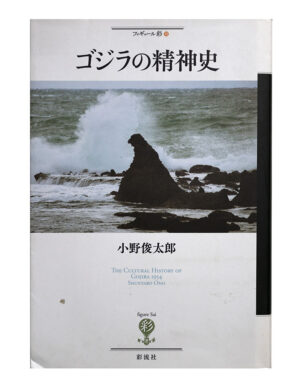2.25.2023
The Cultural History of Godzilla – Pt 32


P 81
新吉はまだ子供だが、母親と兄の死去のあとで大戸島を離れて、いつしか山根家の一員のようにふるまっている。だが、こういう瞬間には肉親を喪失した者の代表となる。そして、新吉の「ちくしょ「う」の声に賛同した者たちは、戦闘機によるゴジラ攻撃を歓呼の声で迎えることになる。破壊を終えゴジラは帰り支度で、すでに海に向かっていたように見える。勝鬨橋はあくまでも海へ帰るのに邪魔になったから排除しただけかもしれない。ゴジラのほうが一方的に勝鬨をあげていることに新吉たちがいらだっていたのだ。
Shinkichi is still a child, but after the death of his mother and older brother, he left Odo Island and before he knew it, he was acting like a member of the Yamane family. But at moments like this, he represents a man who has lost his immediate family. And those who agreed with Shinkichi’s voice of “fuck” will welcome Godzilla’s attack by fighter planes with cheers. After destroying it, Godzilla is ready to go home, and it looks like he’s already heading for the sea. Kachidoki Bridge may have been removed because it was a hindrance to returning to the sea. Shinkichi and others were irritated by Godzilla’s unilateral victory.
ゴジラが破壊する東京の姿は近代建築と都市計画の延長上にある。とりわけ関東大震災のあとで復興したモダン建築を集中的に破壊している。関東大震災を乗り越えた一九三〇年代には文化が爛熟して「エロ・グロ・ナンセンス」の時代を迎えた。発禁となった『エロエロ草紙』で有名な酒井潔は「モダン東京は轟々と成長した。それは破瓜期の処女がのびのびと美しく育まれるように、今はもうちくちく震災でペシャンコになった惨めな姿はどこにもない」と『日本歓楽郷案内』(一九三一年)のなかで述べている。世界大恐慌もどこ吹く風で、エロに金を落とすべきという姿が、同時に戦争へと向かう世相とも相まっている。そして、酒井も使っているが、香山滋も東京を「帝都」と表現している。戦前との連続性があるし、空襲によっても滅びなかったわけだ。
The appearance of Tokyo destroyed by Godzilla is an extension of modern architecture and city planning. In particular, he intensively destroyed modern buildings that had been rebuilt after the Great Kanto Earthquake. In the 1930s, after overcoming the Great Kanto Earthquake, culture matured and ushered in an era of “erotic grotesque nonsense.” Kiyoshi Sakai, who is famous for his banned “Ero guro nansensu”[erotic, grotesque, and nonsense], said, “Modern Tokyo has grown tremendously. It is nowhere to be seen,” he wrote in his book “Guidance to Japan’s Paradise” (1931). Shigeru Kayama also describes Tokyo as the “Imperial Capital,” which is also used by Sakai. There is continuity with the prewar period, and it was not destroyed by air raids.
Wikipedia)
ゴジラが東京を破壊していくようすは、明暦をはじめとする江戸の大火、上野戦争、関東大震災、東京大空襲と「江戸=東京」を焼け野原にした過去の火災を想像させるが、同時にそこから「復興」してきた「都」としての姿ともつながっている。次々と破壊されるモダン建築は、関東大震災の復興のなかで建設され、空襲すら生き延びた建物であることが重要な点なのだ。今回のゴジラ戦争が終結したあとも、戦後復興が待っているはずだ。
The sight of Godzilla destroying Tokyo makes us imagine the fires of the past, such as the Great Fire of Edo, the Great Fire of Meireki, the Ueno War, the Great Kanto Earthquake, the Great Tokyo Air Raid, and the fires that turned “Edo = Tokyo” into a burnt field. It is also connected to the appearance of the “capital” that has been “revitalized” since then. The important point is that the modern buildings that are being destroyed one after another were built during the reconstruction of the Great Kanto Earthquake and survived even the air raids. Even after this Godzilla war is over, post-war reconstruction should be waiting.

P 82
災害や戦争による大火を潜り抜けることで、防災やときには防衛の観点から都市が姿を変えることはよくある。ロンドンやシカゴの大火が町の様子を一変させたことはよく知られる。ロンドンは木造から石造りなどの建築に変わり、シカゴは都市計画を整備した。一方的に荒廃していくのではなくて、たくましく復興する自信があるからこそ、『ゴジラ』のような「惨劇映画」や「災厄映画」が成立する。一方で過去の忌まわしい記憶を想起しながらも、ゴジラが破壊する様子を安心して見られるのはそのせいなのだ。
Cities often change their appearance in terms of disaster prevention and sometimes defense as they survive the conflagration of disasters and wars. It is well known that the great fires of London and Chicago changed the face of the city. London changed from wooden to stone architecture, and Chicago improved its urban planning. “Tragedy movies” and “disaster movies” such as “Godzilla” are established because there is confidence that they will recover strongly, not one-sidedly devastated. On the other hand, it is because of this that we can safely watch Godzilla destroying things while recalling the abominable memories of the past.